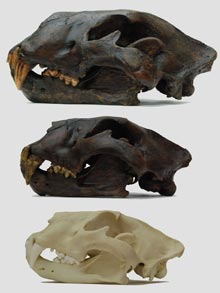
Previously, scientists had thought prehistoric big cats were more like jaguars or tigers.
However comparisons between the skulls of modern big cats and the fossilised remains of their ancestors revealed the animals found in the British Isles, Europe and North America as recently as 13,000 years ago were more like lions.
Dr Ross Barnett, who conducted the work at Oxford University's Department of Zoology, said the extinct species were "supersized lions" that hunted giant deer and woolly mammoth in a frozen landscape.
"These ancient lions were like a supersized version of today's lions, up to 25 per cent bigger than those we know today and, in the Americas, with longer legs adapted for endurance running.
"What our genetic evidence shows is that these ancient extinct lions and the lions of today were very closely related. Meanwhile, cave art suggests that they formed prides, although the males appear not to have had manes."
The researchers looked at remains of animals from the Pleistocene period (1.8 million years ago - 10,000 years ago). Fossils have been found in Germany, Siberia, Europe, Alaska and Wyoming in the USA.
Dr Barnett said the "Pleistocene lions" could be divided into two genetically distinct subgroups. One that inhabited northern Eurasia as well as Alaska and the Yukon and the other that lived in the southern half of North America.
He added: "This unusual distribution is explained by Ice Age geography when a land bridge linked Siberia and Alaska, enabling ancient lions to cross from Eurasia into North America. At some point the North American ice sheets would have interrupted this migration route - creating these two genetically distinct groups of animals."
The animals would have lived in a very different world from the African savannah, hunting for mammoth and giant deer in a landscape that represented the modern Russian Steppe. No one knows why they went extinct, but it has been suggested humans may have contributed to the decline.



Reader Comments
to our Newsletter